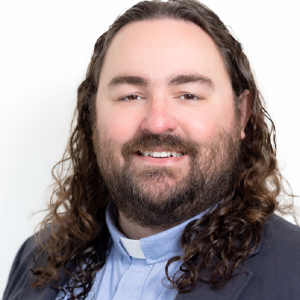GUEST WRITER: PATRICK LANDAU
How do you welcome neurodivergent youth into your churches, ministries, and youth groups?

What is Neurodivergence?
Neurodivergence, a label coined in the ’90s, is a shortened version of “neurological diversity.” Neurological diversity is the idea that people’s brains are all different. Rather than treating people whose brains process the world differently as abnormal, neurodivergence encourages us to recognize and support the diversity of brains God has created.
Who are Neurodivergent Youth?
Neurodivergent is not a precise medical term but a broad category describing how brains work. Some neurodivergent youth have a diagnosis such as ADHD, autism, dyslexia, Tourette syndrome, or others—but many do not. In many cases, accessing the necessary medical care to receive a diagnosis can be difficult. And some youth can “mask” well, meaning they have learned to blend in with average or neurotypical youth. We should never assume someone is neurotypical just because they do not have a diagnosis. You can learn more here.
There are many characteristics associated with neurodivergence. One neurodivergent youth may experience several characteristics, while another may only experience one. Consider some of these examples:
- Social Skills: Neurodiverse youth may ignore common social conventions or need help understanding social cues.
- Speech/Language: Neurodiverse youth may struggle with language or verbal communication. Some are nonverbal, meaning they do not use verbal communication at all.
- Sensory Sensitivity: Neurodiverse youth may be more sensitive to light, sound, temperature, or other sensory inputs. A noise that may irritate a neurotypical person might be painfully uncomfortable to a neurodiverse person.
- Physical Behaviors: Neurodiverse youth may display different behaviors than neurotypical youth. These can include avoiding eye contact, rocking back and forth, flapping arms, or tics.
- Transitions: Neurodiverse youth may become engrossed in an activity or comfortable with a particular schedule, making transitioning to a different activity or changing plans difficult. Or, they may get hung up on an issue that seems unimportant to a neurotypical person.
Tips for Welcoming Neurodivergent Youth

Welcoming neurodivergent youth into your ministry isn’t about having all the right tools or knowing every term—it’s about cultivating awareness, empathy, and flexibility. Whether you’re new to this conversation or already making changes, there are practical ways to ensure your space and leadership style are more inclusive. Below are a few tips to help you begin creating an environment where neurodivergent youth feel seen, safe, and celebrated.
Tip 1: Take inventory of sensory stimuli in your space.
Walk into the room where your youth meet and pay attention to your senses. Listen for the sound of the lights or the heater. Notice whether the space looks busy. Is it organized or a chaotic mess? Is there a smell, whether good or bad? Are tables sticky?
Some neurodivergent youth take in more sensory input than neurotypical youth. This means neurodivergent youth might hear the lights buzzing, the heater turning on, the chatter in the hallway, and the traffic outside, and may struggle to focus. Add to that a messy, chaotic youth space with posters or decorations everywhere, loud music, and dim lighting, and the room can seem overwhelmingly uncomfortable.
Consider what adjustments can create a more calming environment. Add some rugs or acoustic tiles to minimize noise if the space echoes or is too loud. Consider switching to lamps if the lighting is harsh. Consider adding cabinets or storing things in a closet if the space is cluttered. And try eliminating odors. Even a scented candle can be overwhelming or distracting for some folx, not just neurodiverse youth.
Tip 2: Explain social norms and interactions.

Social norms can be incredibly random. For example, if you were asked how you are doing, a perfectly acceptable response is to state the day of the week. Consider this conversation:
Person 1: “How’s it going?”
Person 2: “It’s Friday!”
Person 1: “That it is.”
Most neurotypical people will know that saying “It’s Friday!” is generally a happy statement because it is the typical end of the work week. But logically, it doesn’t make sense. Neurodivergent youth may hear this exchange and be confused, wondering what just happened.
Neurodiverse youth may not pick up on social rules or conventions, especially those that seem arbitrary. Do not assume a student is being obtuse or trying to cause trouble. Instead, make it a common practice to explain social dynamics.
Tip 3: Say exactly what you mean.

We often do not say precisely what we mean. Take a simple icebreaker, for example, like asking about people’s favorite movies. The point of the icebreaker is to share a bit of personal information in hopes of getting the conversation going and making connections. The point is not necessarily to know the person’s actual favorite movie.
Some neurodiverse youth will want to answer the literal question: What is your favorite movie? This task may become frustrating because narrowing down their favorite movie might take some time. They want to answer honestly, not realizing that any movie they like will do.
Now, consider giving instructions. It might feel frustrating if, as a youth leader, you were to tell a group, “Go sit down,” and a student sits in the chair closest to them rather than going to where the group is sitting. But there’s a good chance they would have no intention of being difficult and feel they’re doing exactly what you said. When a neurodiverse youth is not doing what’s expected, step back and ask, “Did I say exactly what I meant?”
Tip 4: Prepare for direct, “overly” honest responses from neurodiverse youth.

Many neurodiverse youth may not understand the nuance between a polite response and direct honesty. Imagine getting a bad haircut and then walking into a room of students to ask what they think. Neurotypical youth might say something polite or subtly make fun of it, while some neurodiverse youth will give you an honest Yelp review.
If the worship leader asks a neurodiverse youth what they thought of the music, the student might respond that it was out of rhythm and a bit pitchy, whereas a neurotypical youth might just say, “It was fine.” For some neurodiverse youth, direct honesty is more comfortable or preferred compared to the nuances of social politeness.
Model how to respond to this different communication style. Do not get defensive or call the student rude. Instead, take a breath and consider whether they were intentionally insulting, mean, or simply being honest. Often, the tendency is to chastise the honest person for being “rude.” If we do that, how can we later say we value truth or honesty? Neurotypical youth and leaders might need to learn only to ask questions if they really want an answer, while neurodiverse youth might need to learn to ask if someone is looking for support or honesty.
Tip 5: Foster an environment where all children and youth feel comfortable.
Many grew up hearing, “Children are to be seen and not heard.” The ultimate evidence of a “good” kid was whether they behaved, which usually meant sitting still and quiet until called upon. Unfortunately, for many neurodiverse youth, it is difficult, if not impossible, to sit still and make no noise. It can be helpful to ask: Are their behaviors actually disruptive?
Welcome everyone to show up in the way that feels most comfortable for them. If a youth is standing at the back of the room swaying rather than sitting in a chair, let them. If a youth makes involuntary noises, normalize it. Work to create an environment that prioritizes inclusivity and comfort rather than stillness and quiet.
You may need to start with education to change your ministry’s culture. Even neurotypical youth are meant to be active and social. Consider changing the mindset from “Children are to be seen and not heard” to “Youth are welcome to be themselves.” Create times for noisiness and contemplation, movement and stillness. All children and youth deserve to experience God’s loving community and should be celebrated for being themselves.
Believe in the Diversity of God’s Children
At the heart of this, welcoming neurodivergent youth requires a belief in the diversity of God’s creation. If everyone is uniquely and wonderfully made, then we know we need to approach some youth differently than others.
We will be effective in welcoming neurodiverse youth when we set aside judgment, create spaces with them in mind, and celebrate their own unique, God-created selves.

Patrick Landau
Reverend Patrick is a minister, writer, father, husband, scrapbooker, and occasional choral composer. He has worked in almost every area of the church, including the nursery, VBS, youth group, campus ministry, young adult ministry, mission trips, website maintenance, and more. Currently, he pastors Spirit of Hope Metropolitan Community Church in Kansas City, Missouri, where he teaches that God’s inclusive love is for everyone regardless of age, gender, orientation, race, ethnicity, class, disability, or neurodiversity.

Jon Humphries says
Great and helpful piece.